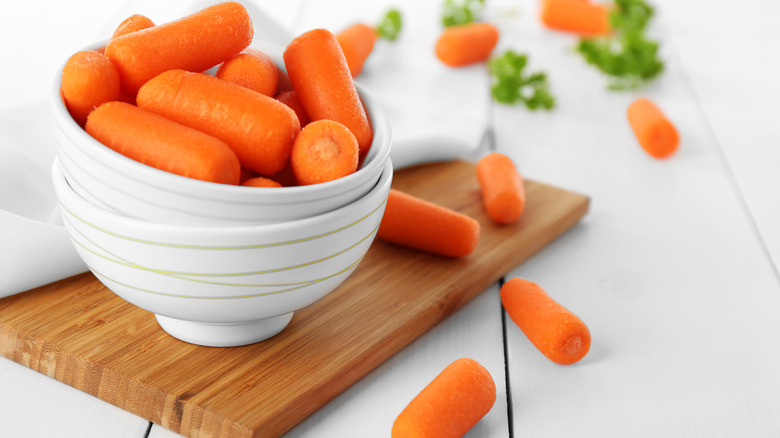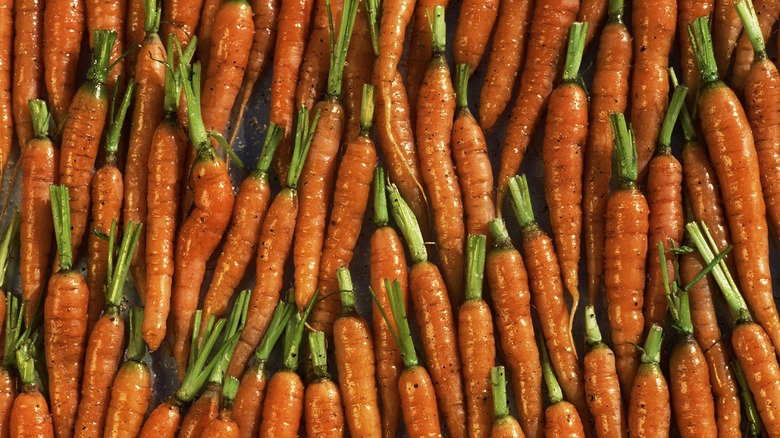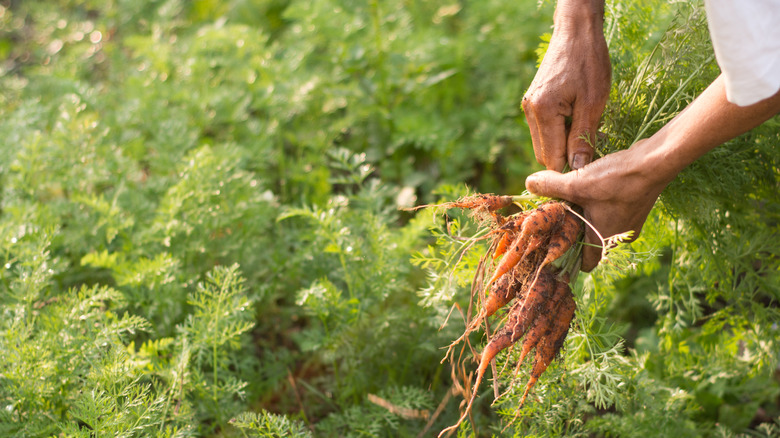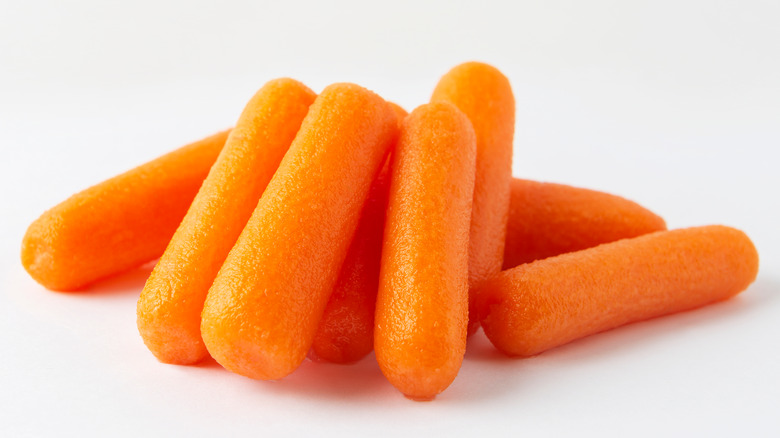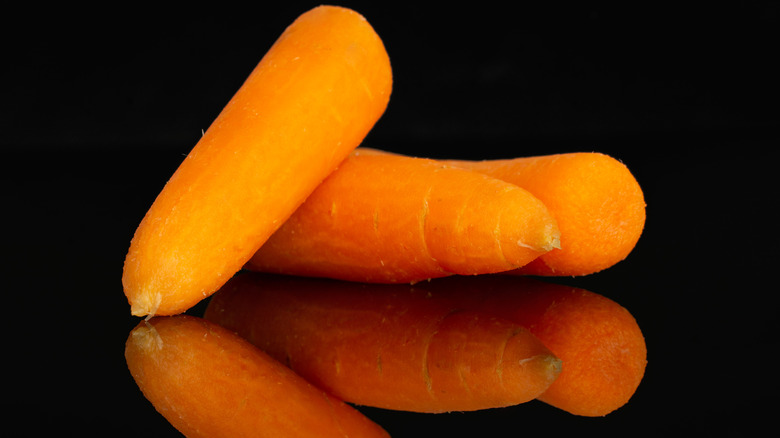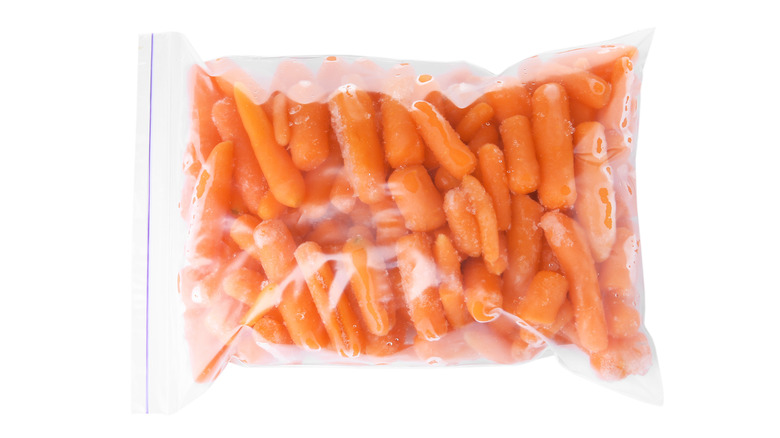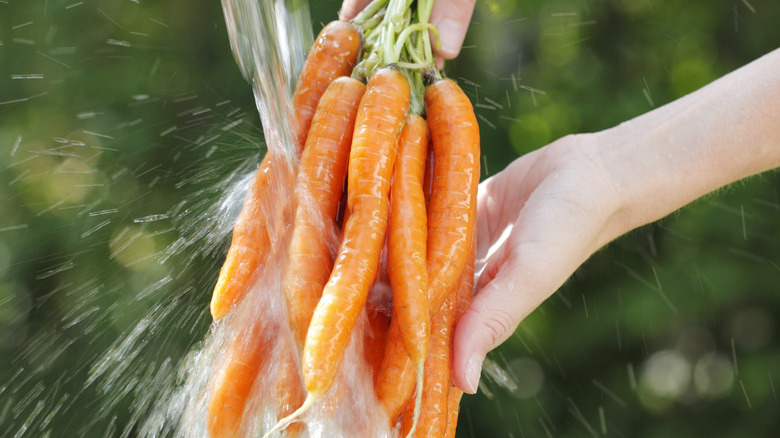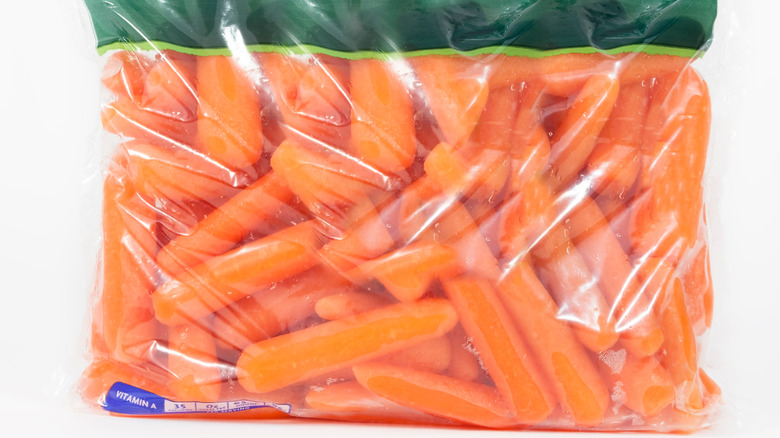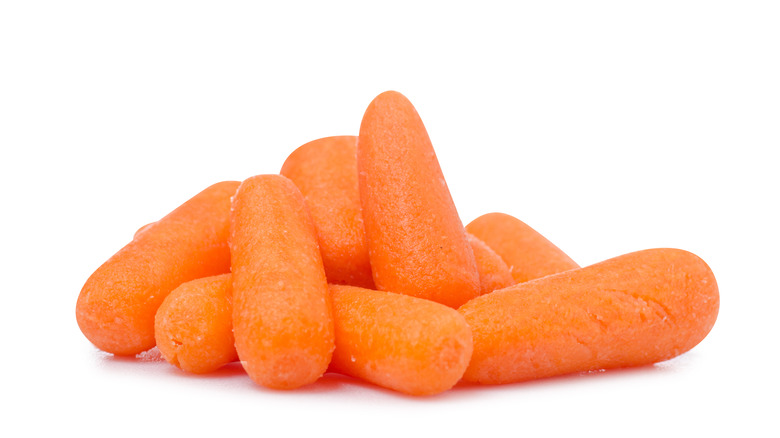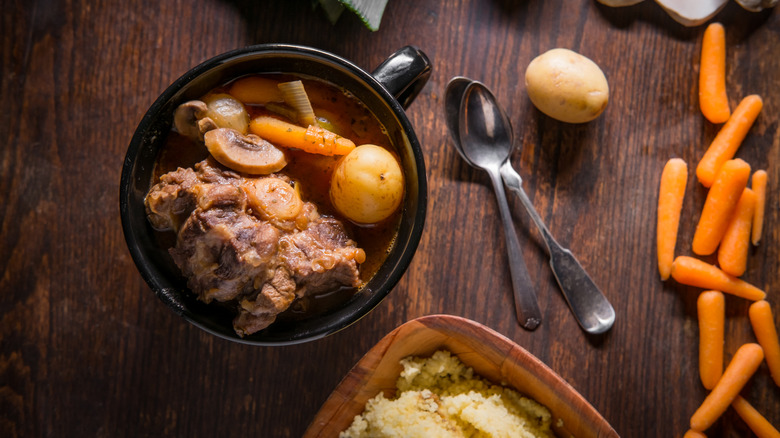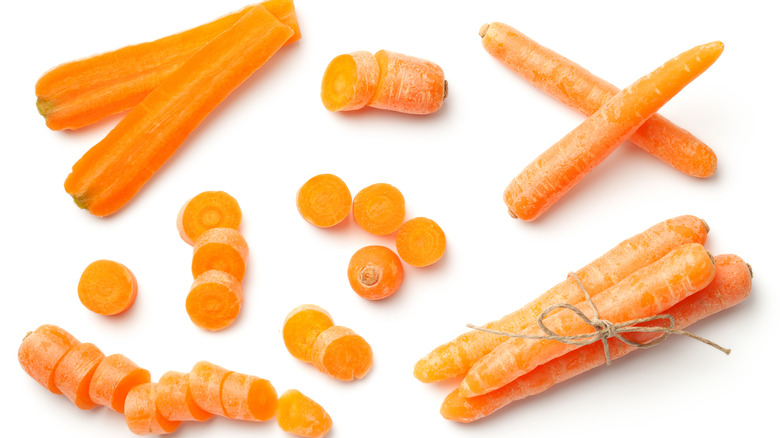10 Answers To All Your Baby Carrot Questions
Walk into any supermarket, and you are bound to find bags of baby carrots lining the shelves of the produce case. An ever-popular produce choice, baby carrots are cute and fun. You don't have to worry about peeling or chopping them. Sold in convenient bags, they make for an easy snack on the go. Plus, children love this bite-sized veggie, giving parents a relatively painless way to get their kids to eat their vegetables.
Despite being ubiquitous today, baby carrots did not even exist 40 years ago. Yet by 2016, baby carrots would make up almost 70 percent of all carrot sales in the United States, helping to save an industry that otherwise would produce a lot of waste (via The Washington Post).
These small carrots may be favored among the masses, but do we actually understand what they are? A lot about this crunchy orange vegetable is still a mystery, so we are answering all your burning baby carrot questions from how they are produced to explaining what that white stuff is on your carrots.
What exactly are baby carrots?
Because so many people start eating this vegetable at a very young age, it is understandable how the myth of baby carrots being naturally grown that way continues to spread. Contrary to popular belief, baby carrots do not come out of the ground in that perfectly rounded 2-inch long shape. Baby carrots come from mature carrots that have been cut down to that size. In the grocery store, baby carrots are typically labeled baby-cut carrots or petite baby-cut carrots, not baby or young carrots.
There is nothing inherently natural about baby carrots. They didn't even exist on the market before the 1980s. California farmer Mike Yurosek, like many other carrot producers of the 1980s, was struggling to get supermarkets to buy his carrots. They only wanted to sell the most picture-perfect vegetables for consumers, and there weren't yet companies like Imperfect Foods or Misfits Market looking to buy up ugly produce. So in 1986, Yurosek invented the product we know today by turning his imperfect carrots into uniform nubs that were much more visually appealing (via Huff Post). Not only did this reduce food waste, but it helped an industry that was struggling financially. Baby carrots were an instant hit, and Yurosek changed the vegetable industry with his little idea.
How are baby carrots grown and harvested?
California is the leading producer of baby carrots. The state produces over 85% of carrots grown in the United States in general, as they have an ideal climate for growing bright, colorful roots (via the Agricultural Marketing Resource Center). Carrots get their characteristic color when the air temperature is between 60 F and 70 F.
If you have ever seen large bulk carrots (sometimes called horse carrots), you know how big they can grow, at times a few inches in diameter. So how do baby carrot producers get their roots so small? Huff Post explains that most baby carrot growers cultivate the Imperator variety and plant them close together, which forces them to grow long and thin.
According to the Agricultural Marketing Resource Center, Imperator carrots are also generally harvested young, while they are still fairly small, making it easier to cut into the classic baby carrot shape. This variety of carrots is also sweeter and more flavorful when they are young, making it the optimal variety for baby carrot production, notes Gardening Know How.
How are baby carrots processed?
Once harvested, carrots must be cut into shape. After first using a potato peeler to make baby carrots by hand, Yurosek settled on an industrial green bean peeler to make his 2-inch uniform product (via Huff Post). Today, baby carrots are mass-produced using mechanical equipment. This YouTube video gives a good demonstration of how baby carrots are processed (interesting, right?).
The carrots are first washed and put through a machine that removes the green stems. Then, they are cut into 2-inch long pieces. The machines are built to remove pieces that are too thick or too small. They are also sorted by diameter size, which explains why you often see bags of all tiny baby carrots or all thicker ones. Continuing the process, stone rollers peel and polish the carrots before getting bagged to sell at your local grocery store. Over the past few decades, this method has become more and more automated (like most other processed produce) relying on machinery to quickly cut and package baby carrots (or baby-cut carrots, we should say).
Are baby carrots peeled?
The short answer to this question is that, yes, baby carrots are peeled, but it goes beyond the simple shaving of the outer skin like you would at home when you buy full-size carrots. You've probably noticed that baby carrots are super smooth and do not have any of those hairy roots found in full-size carrots. That is because they are mechanically peeled to perfection.
Once the carrot pieces have been cut into 2-inch pieces, they go into a stone roller machine that peels and polishes them (via Business Insider). That is how they get those rounded edges and glossy surfaces. Part of the charm of baby carrots is that they are already peeled. Although fresh-cut carrots are a great addition to a crudités platter, it is hard to beat the convenience of pre-peeled baby carrots. When packing school lunches in the morning, who has the time to get out a peeler and a cutting board? It's not shocking that baby carrots lead in sales when considering everyone's busy lifestyles.
Why are baby carrots always wet?
Take a look at the row of baby carrot packages next time you go grocery shopping. What do they have in common and how does that differ from other carrots? All the bags will have some water in them, as opposed to full-size carrot bags, which are typically dry. Fear not, the moisture is not a cause for concern. This is the real reason why baby carrots are always wet.
The liquid in the bag is simply filtered tap water, and it helps keep the carrots fresh. When baby carrots dry out, they are not very pleasant to eat. By being bagged with a little bit of water, your baby carrots will stay hydrated for longer. Because they are peeled, baby carrots have a shorter shelf life than whole unpeeled carrots. Although some sources claim baby carrots can be kept for three-to-four weeks in the fridge, the consensus is that they last for one-to-two weeks refrigerated. Unpeeled carrots tend to last for three-to-four weeks in the fridge (via Glad), so the water in the package is helping to extend the freshness of this vegetable. Without that water, all the packages of baby carrots in the store would likely have a white coloration on the surface that would make people not want to buy them.
Are baby carrots soaked in chlorine?
Sometimes, people express concern that the liquid in the bags of baby carrots contains chlorine, but this is a misconception. It's just filtered tap water used to keep the carrots hydrated. However, the myth about chlorine did not completely come out of left field.
Baby carrots must be carefully processed to avoid food causing foodborne illnesses. One of these food safety measures is washing the carrots with chlorinated water. This is a practice that is very common with commercially sold fresh produce (via the University of Vermont). These chlorine solutions are safe for consumption and can even better prevent pathogens from spreading than water alone.
If you are still concerned about chlorine touching your food, rest assured, it is not harmful. The amount of chlorine in these rinses is less than you might find in your drinking water, and the process only takes 48 hours. The carrots in those little bags did not have long-term contact with chlorine, and the use of this chemical is only to improve the safety of your food.
How best to keep baby carrots fresh
Biting into a fresh baby carrot is one of the most satisfying food sounds. That distinct snap signals that you are eating a fresh carrot, and it's terribly disappointing when you bite down to find your carrots have lost their crunch. As we already noted, carrots in general have a fairly long shelf life when kept in the fridge, but baby carrots are more susceptible to losing their luster by drying out. Here's how to best store your baby carrots so they're fresh and crisp.
A liquid is your friend when storing carrots of all kinds. Unopened bags of baby carrots provide their own moisture. That filtered tap water helps prevent the carrots from drying out, but what happens once you open the bag? Some bags have resealable ziplock tops, but not all do. There is a better solution than loosely tying the bag and hoping the carrots in it will stay fresh. If you go through a bag of baby carrots in a few days, then you probably don't need to worry about them getting dry. However, if you want to extend the life of your carrots, it is best to repackage them. Store baby carrots in the fridge in an airtight container covered with water. If the water starts to turn murky, just give it a fresh batch of water. This way, you could potentially add weeks of freshness to your baby carrots. This trick works for whole carrots, as well.
Nutritional info on baby carrots
Unfortunately, the processing of baby carrots does remove some of their nutrients. The good news is that baby carrots still maintain a high level of nutritional value. According to the U.S. Department of Agriculture, one large baby carrot has just five calories, 0 grams of fat, 0 milligrams of cholesterol, and only 1 gram of carbs. A standard 85-gram serving contains 30 calories, 7 grams of carbohydrates, 2.5 grams of dietary fiber, and 4 grams of sugar.
Baby carrots also contain several useful nutrients. They are very high in vitamin A and include 84% of the daily recommended value for adult women and 65% for adult men (via Dietary Guidelines for Americans). Each serving also contains 27 milligrams of calcium, 201 milligrams of potassium, and 8 micrograms of vitamin K, along with a trace amount of other vitamins and minerals. Overall, carrots are considered to be a health-friendly food. The Cleveland Clinic notes that carrots have been shown to reduce the risk of some cancers and lower cholesterol, which has been linked to lowering the risk of heart disease. Additionally, the tale your mom told you about eating carrots to improve your vision may not be true, but studies have shown that the antioxidants found in carrots could reduce the risk of age-related vision loss (macular degeneration). Sorry to all the moms out there who have been doubted.
Best ways to use baby carrots
A veggie tray just wouldn't be the same without baby carrots. Who hasn't dipped these little veggies into some ranch dressing or hummus? While there will always be a time and a place for carrots and dip, baby carrots can go far beyond snack time.
Baby carrots would make a great addition to your Sunday roast or similarly flavored beef stews. Roast chicken and carrots are also a match made in heaven. Baby carrots shine in our recipe for spring chicken with carrot broth and baby carrots. You can also try using baby carrots in any recipe that calls for young carrots. Roasting baby carrots will bring out more of their natural sweetness through the process of caramelization. They would taste great in this recipe for Moroccan-spiced carrots. Just keep in mind that baby carrots are smaller and may have shorter cooking times. You could even add finely grated baby carrots in zucchini bread batter to make zucchini carrot bread that your kids (and you) will love without knowing they are full of veggies. There are so many opportunities to liven up baby carrots.
What's the white stuff on your baby carrots?
So you have left a partially eaten bag of baby carrots in your fridge for a couple of weeks, and they have developed this white coloration. Do you need to throw them away?
Given that baby carrots are briefly rinsed in chlorine, some people have come to believe that this white film is visible chlorine, but this is what the white stuff on your baby carrots really is: The white film is known in the produce industry as "carrot blush." It is a naturally occurring phenomenon that occurs when carrots lose their moisture. It happens to full-size carrots, too. When the surface of carrots drys out, it becomes rough, and light that hits the surface will give off a white hue (via McGill University). It is also possible that carrot blush could be caused by the cell walls of the carrots being bruised and damaged during transit.
Carrot blush is completely safe to eat and is not an indication that your baby carrots have gone bad. To restore your carrots, all you need to do is give them hydration. Soak your carrots in water for a few minutes, and they should look fresh and crisp again. If the whiteness is still there, then it is probably a result of damage to the cell walls, which cannot be restored. In either case, the carrots are still safe for consumption. There is no need to throw out those dried-out-looking carrot sticks.
